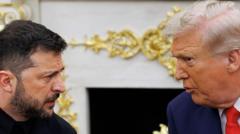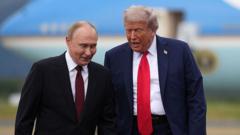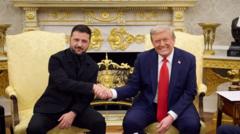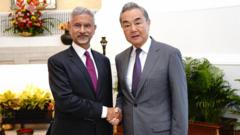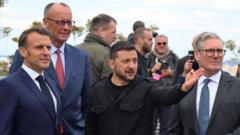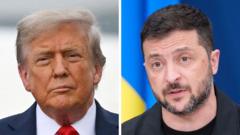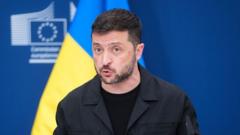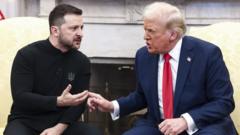The recent meeting between President Trump and President Zelensky showcased the significant role a map displayed in the Oval Office played in conveying the current state of the Ukraine conflict. While Trump emphasized the portions of Ukraine under Russian control, Zelensky offered a contrasting view aimed at countering misconceptions, presenting a complex image of territorial claims and military dynamics.
The Role of the Oval Office Map in Shaping U.S. Perspectives on the Ukraine Conflict
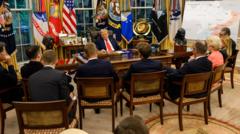
The Role of the Oval Office Map in Shaping U.S. Perspectives on the Ukraine Conflict
A detailed examination of how a map presented during discussions between President Trump and President Zelensky highlights differing interpretations of territorial control in Ukraine.
In the latest developments regarding the ongoing Ukraine conflict, a map prominently displayed in the Oval Office has emerged as a pivotal tool illustrating the territorial tensions that underpin discussions between key world leaders. This map, shaded in red to signify areas occupied by Russian forces, was central to conversations between U.S. President Donald Trump and Ukrainian President Volodymyr Zelensky on Monday.
Trump’s remarks following the meeting underscored the map’s stark message: significant swathes of Ukrainian territory have been seized by Russia, highlighting the need for potential territorial compromises or land swaps with Russian President Vladimir Putin. “I assume you've all seen the map,” Trump stated, directly stating the implications of the occupied zones. The implication from the White House suggests a readiness for Ukraine to consider negotiations over its territorial integrity in light of the military might displayed by Russia.
In contrast, Zelensky and his team prepared to address the narrative reflected in the map during their meeting, with Zelensky fighting for a more accurate representation of the conflict's reality. He noted the ongoing struggle for what the map depicted, focusing on the actual balance of control rather than merely the visuals. Zelensky found some success in correcting misperceptions concerning Russian territorial control—asserting that maps should reflect the real situation on the ground, not bases solely on claims.
The map was not merely a decorative element but a graphic representation of Russia's occupation—a fifth of Ukraine is currently under its control, particularly the economically vital regions like Donbas. According to analysts, areas like Donetsk and Luhansk are core targets for Russia, which has expressed intentions to fully incorporate these regions into its sphere as part of peace negotiations.
Despite the threats and territorial challenges, a closer examination reveals that there remains a significant Ukrainian presence and resistance in contested areas. Reports detail that Ukrainian forces maintain control over substantial sections and that much of the land initially lost has been recaptured.
While conversation around the map continued, military analysts noted that although Russia has shown advances in recent months, overall progress has been limited, with Ukraine maintaining a firm hold over substantial segments of its territories. This dynamic is crucial for understanding the disparity in perspectives between Zelensky's insistence on Ukrainian sovereignty and Trump's recognition of Russia’s advances. As both leaders navigate their positions, the inherent complexities of territory, control, and perception continue to shape the discourse surrounding the Ukraine conflict.
In the midst of these negotiations, Zelensky's focus remained on leveraging the presented map to rally support and maintain a strategic advantage in ongoing discussions, highlighting the differing priorities and interpretations of military realities at play.
Trump’s remarks following the meeting underscored the map’s stark message: significant swathes of Ukrainian territory have been seized by Russia, highlighting the need for potential territorial compromises or land swaps with Russian President Vladimir Putin. “I assume you've all seen the map,” Trump stated, directly stating the implications of the occupied zones. The implication from the White House suggests a readiness for Ukraine to consider negotiations over its territorial integrity in light of the military might displayed by Russia.
In contrast, Zelensky and his team prepared to address the narrative reflected in the map during their meeting, with Zelensky fighting for a more accurate representation of the conflict's reality. He noted the ongoing struggle for what the map depicted, focusing on the actual balance of control rather than merely the visuals. Zelensky found some success in correcting misperceptions concerning Russian territorial control—asserting that maps should reflect the real situation on the ground, not bases solely on claims.
The map was not merely a decorative element but a graphic representation of Russia's occupation—a fifth of Ukraine is currently under its control, particularly the economically vital regions like Donbas. According to analysts, areas like Donetsk and Luhansk are core targets for Russia, which has expressed intentions to fully incorporate these regions into its sphere as part of peace negotiations.
Despite the threats and territorial challenges, a closer examination reveals that there remains a significant Ukrainian presence and resistance in contested areas. Reports detail that Ukrainian forces maintain control over substantial sections and that much of the land initially lost has been recaptured.
While conversation around the map continued, military analysts noted that although Russia has shown advances in recent months, overall progress has been limited, with Ukraine maintaining a firm hold over substantial segments of its territories. This dynamic is crucial for understanding the disparity in perspectives between Zelensky's insistence on Ukrainian sovereignty and Trump's recognition of Russia’s advances. As both leaders navigate their positions, the inherent complexities of territory, control, and perception continue to shape the discourse surrounding the Ukraine conflict.
In the midst of these negotiations, Zelensky's focus remained on leveraging the presented map to rally support and maintain a strategic advantage in ongoing discussions, highlighting the differing priorities and interpretations of military realities at play.

